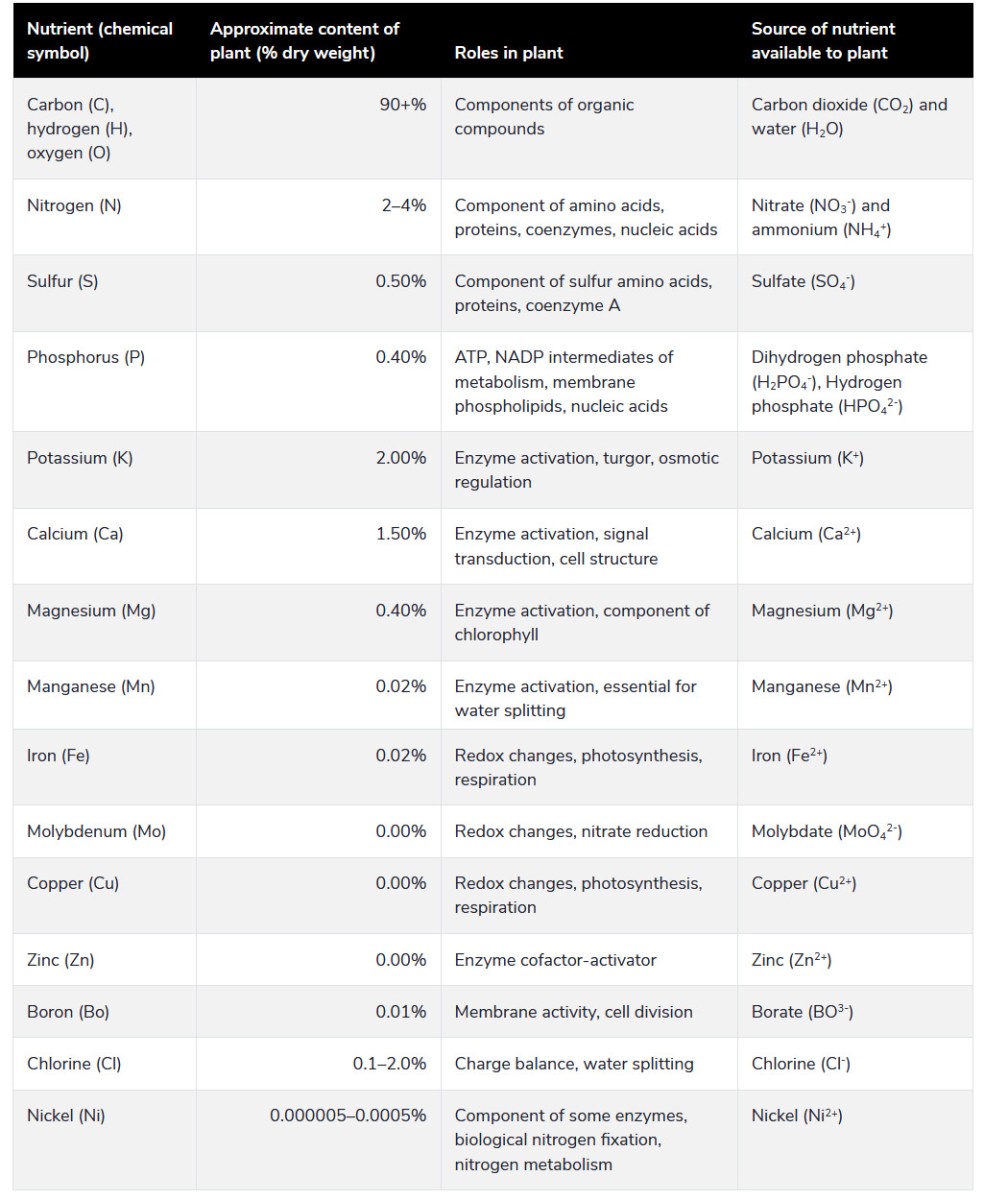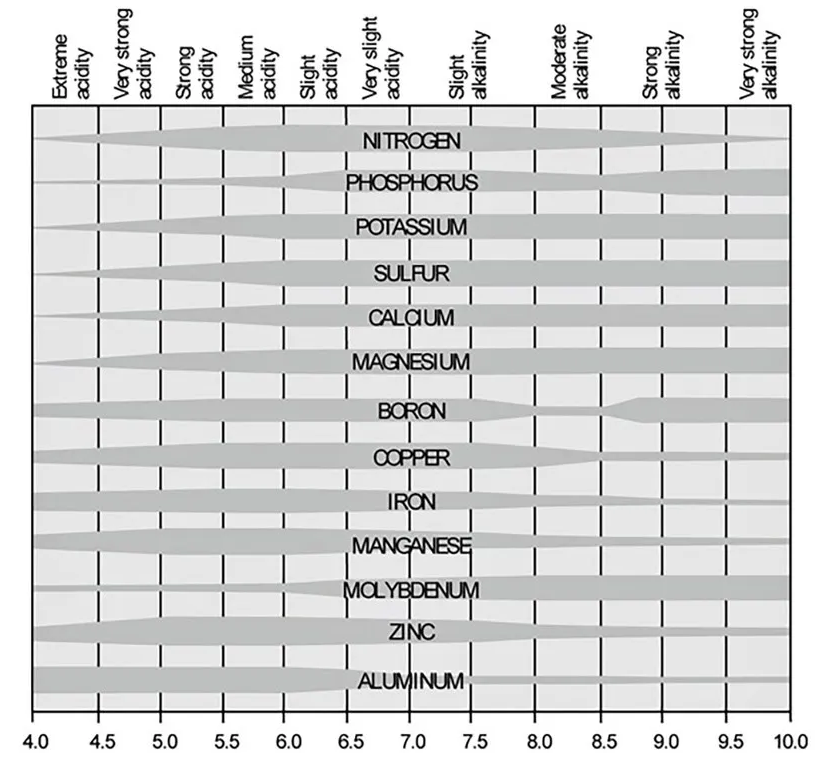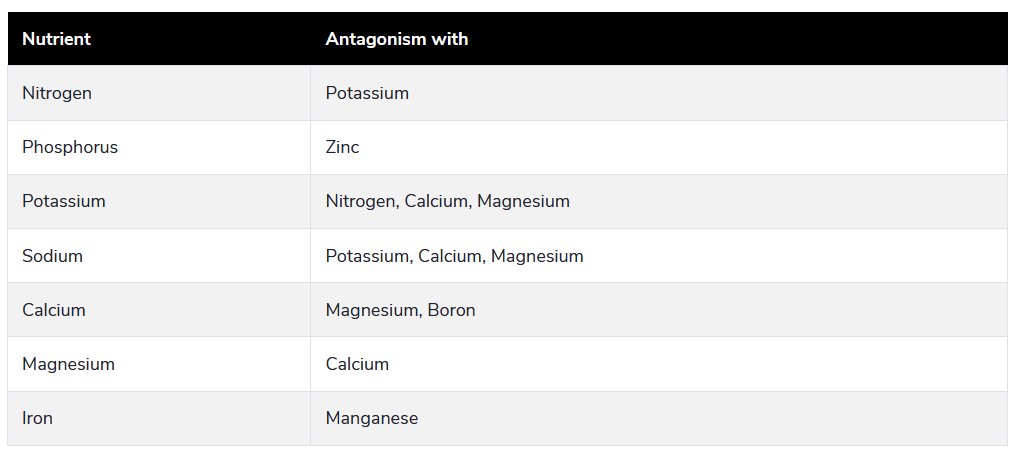Essential Nutrients
Plants cannot properly function without 17 essential nutrients. These nutrients are needed so that processes critical to plant growth and development can occur.
Essential nutrients can be broadly categorized as macronutrients and micronutrients. Macronutrients and micronutrients are both essential for plant growth and development. Macronutrients include carbon, hydrogen, oxygen, nitrogen, phosphorus, potassium, sulfur, calcium, and magnesium. Micronutrients include iron, manganese, zinc, boron, molybdenum, chlorine, copper, and nickel. The difference between macro- and micronutrients is the amount required by plants. Macronutrients are required in higher amounts than micronutrients.
Plants get carbon, hydrogen, and oxygen from air and water. The rest of the nutrients are from soil or in the case of hydroponics from nutrient solutions or aggregate media.

pH
It is impossible to discuss plant nutrition without considering pH. In hydroponics, we are primarily concerned with the pH of the water used to make up nutrient solutions and irrigate plants. pH is a measure of the relative acidity or hydrogen ion concentration and it plays an important role in plant nutrient availability. It is measured using a 0- to 14-point scale where 0 is the most acidic, 7 is neutral, and 14 is the most alkaline. The scale is logarithmic, and each unit represents a 10-fold change. This means that small changes in values are large changes in pH. For example, a value of 7 is 10 times higher than 6 and 100 times higher than 5. In general, the optimal pH range for growing vegetables hydroponically is 5.0 to 7.0.
This chart shows the relationship between nutrient availability and pH:

Along the bottom of the chart are different pH values between 4.0 and 10.0. At the top of the chart, the relative acidity or alkalinity is shown. Within the chart, relative nutrient availability is represented by a bar. The wider the bar is, the more the nutrient is relatively available. For example, the nitrogen bar is widest between a pH of 6.0 to 7.5. This is the pH where it is most available to plants. It is very narrow between 4.0 and 4.5 and not as readily plant available.
It is also important to consider the alkalinity of the water. Alkalinity is a capacity measure. It measures the capacity of the water to neutralize the acid. This is due primarily to the combined amount of carbonate (CO3) and bicarbonate (HCO3), but hydroxide, ammonium, borate, silicate, and phosphate can also contribute.
When total alkalinity is low, the water has low buffering capacity. As a result, its pH will readily change depending on what is added to it. When total alkalinity is high, the pH of the water is high. Acid can be injected with irrigation water to decrease high pH water. The amount of acid needed depends on the alkalinity of the water.
Nutrient Antagonism and Interactions
Nutrients are roughly taken up by plants in roughly the same relative amounts that they are present in the nutrient solution. However, when one nutrient is in excess it can be taken up at a higher amount at the expense of another nutrient. This is nutrient antagonism. In this case, it is possible to have sufficient amounts of a nutrient in the nutrient solution and for plants to be deficient.
For example, a recipe for a hydroponic tomato nutrient solution calls for 190 ppm nitrogen and 205 ppm potassium. Due to an error in calculating amounts of fertilizer to use, 2,050 ppm of potassium is added. Excess potassium in the solution can result in antagonism with nitrogen (and other nutrients) and can result in a nitrogen deficiency even if 190 ppm of nitrogen was added. The table below shows common antagonisms.

Nutrient deficiencies
Nitrogen deficiency
Symptoms:
- Pale green or yellowish leaves, starting from the older leaves at the bottom of the plant and moving up
- Reduced growth and stunted plant size
- Delayed or reduced flowering and fruiting
- Leaves may become brittle and eventually die off
- Reduced root growth and development
- Poor soil fertility: the soil may not have enough nitrogen available for the plants to take up
- Overuse of nitrogen fertilizers: over-fertilization can cause an imbalance of nutrients, leading to nitrogen deficiency
- Environmental factors: cold temperatures or drought can limit the availability of nitrogen in the soil
- Apply nitrogen fertilizers: Nitrogen fertilizers are the most common remedy for nitrogen deficiency. They can be applied in the form of urea, ammonium nitrate, or other sources of nitrogen. However, it is essential to use nitrogen fertilizers in moderation, as overuse can lead to environmental problems.
- Use organic matter: Organic matter, such as compost or manure, can help improve soil fertility and increase the availability of nitrogen in the soil.
- Crop rotation: Growing nitrogen-fixing crops such as legumes, which can convert atmospheric nitrogen into a usable form, can help increase nitrogen levels in the soil.
- Soil testing: It is important to test the soil periodically to determine the nutrient content and pH levels. This can help identify any nutrient deficiencies and enable appropriate fertilization.
Calcium deficiency
Symptoms:
- Stunted plant growth
- Leaf tip burn or necrosis, which is characterized by the browning of leaf margins
- Leaf deformation and curling
- Reduced fruit quality and shelf life
- Brittle stems and root tips
- Poor soil fertility: the soil may not have enough calcium available for the plants to take up
- High soil pH: high soil pH can limit calcium availability in the soil
- Excessive use of potassium or magnesium fertilizers: excessive use of potassium or magnesium fertilizers can interfere with calcium uptake by the plant
- Apply calcium fertilizers: Calcium fertilizers such as calcium nitrate or calcium chloride can be applied to the soil or foliage to increase calcium levels. However, it is important to avoid over-fertilization, as this can lead to other problems such as nutrient imbalances or environmental pollution.
- Use organic matter: Adding organic matter to the soil can improve soil fertility and increase calcium levels. Organic matter sources such as compost or manure can be used to provide a slow-release source of calcium.
- Adjust soil pH: Adjusting the soil pH to a range of 6.0-7.0 can help increase calcium availability in the soil.
Potassium deficiency
Symptoms:
- Chlorosis or yellowing of the leaf margins or in between the veins of older leaves
- Necrosis or death of leaf margins and tips
- Stunted growth and reduced plant vigor
- Increased susceptibility to disease and pests
- Reduced tolerance to environmental stresses, such as drought or extreme temperatures
- Poor soil fertility: the soil may not have enough potassium available for the plants to take up
- Overuse of other nutrients: excessive use of other nutrients such as nitrogen and phosphorus can limit potassium uptake
- Soil pH: high or low soil pH can affect the availability of potassium in the soil
- Soil texture: sandy soils with low organic matter content can have low potassium levels
- Environmental factors: high rainfall or leaching can wash away potassium from the soil
- Apply potassium fertilizers: Potassium fertilizers such as potassium sulfate, potassium nitrate, and potassium chloride can be applied to the soil to increase the potassium levels. However, it is important to avoid over-fertilization, as this can lead to other problems such as nutrient imbalances or environmental pollution.
- Use organic matter: Adding organic matter to the soil can improve soil fertility and increase potassium levels. Organic matter sources such as compost, manure, or cover crops can be used to provide a slow-release source of potassium.
- Adjust soil pH: Adjusting the soil pH to a range of 6.0-7.0 can help increase potassium availability in the soil.
- Crop rotation: Rotating crops can help prevent potassium depletion in the soil, as different crops have different nutrient requirements.
Phosphorus deficiency
Symptoms:
- Dark green or bluish-green leaves with a reddish or purplish tint
- Stunted growth and reduced plant vigor
- Delayed maturity or reduced flowering and fruiting
- Small or underdeveloped root system
- Leaves may turn yellow and die off in severe cases
- Poor soil fertility: the soil may not have enough phosphorus available for the plants to take up
- Soil pH: high or low soil pH can affect the availability of phosphorus in the soil
- Environmental factors: cold temperatures or drought can limit the availability of phosphorus in the soil
- Apply phosphorus fertilizers: Phosphorus fertilizers such as superphosphate, triple superphosphate, and diammonium phosphate can be applied to the soil to increase the phosphorus levels. However, it is important to avoid over-fertilization, as this can lead to other problems such as nutrient imbalances or environmental pollution.
- Use organic matter: Adding organic matter to the soil can improve soil fertility and increase phosphorus levels. Organic matter sources such as compost, manure, or bone meal can be used to provide a slow-release source of phosphorus.
- Adjust soil pH: Adjusting the soil pH to a range of 6.0-7.0 can help increase phosphorus availability in the soil.
- Tillage: Deep tillage or cultivation can help break up compacted soil and increase phosphorus availability for plant roots.
Magnesium deficiency
Symptoms:
- Interveinal chlorosis or yellowing of leaves, usually starting in older leaves
- Leaves may turn brown and curl upwards
- Reduced plant growth and vigor
- Increased susceptibility to environmental stresses and disease
- Poor soil fertility: the soil may not have enough magnesium available for the plants to take up
- High soil pH: high soil pH can limit magnesium availability in the soil
- Soil texture: sandy soils with low organic matter content can have low magnesium levels
- Environmental factors: cold temperatures or excessive rainfall can limit magnesium availability in the soil
- Apply magnesium fertilizers: Magnesium fertilizers such as magnesium sulfate or Epsom salts can be applied to the soil to increase magnesium levels. However, it is important to avoid over-fertilization, as this can lead to other problems such as nutrient imbalances or environmental pollution.
- Use organic matter: Adding organic matter to the soil can improve soil fertility and increase magnesium levels. Organic matter sources such as compost, manure, or seaweed can be used to provide a slow-release source of magnesium.
- Adjust soil pH: Adjusting the soil pH to a range of 6.0-7.0 can help increase magnesium availability in the soil.
- Foliar sprays: Magnesium can be applied as a foliar spray directly to the leaves of plants to provide a quick source of magnesium for the plant.
Manganese deficiencies
Symptoms:
- Interveinal chlorosis or yellowing of leaves, usually starting in the younger leaves
- Leaves may become mottled or have necrotic spots
- Stunted growth and reduced plant vigor
- Poor soil fertility: the soil may not have enough manganese available for the plants to take up
- High soil pH: high soil pH can limit manganese availability in the soil
- Environmental factors: cold temperatures or excessive rainfall can limit manganese availability in the soil
- Apply manganese fertilizers: Manganese fertilizers such as manganese sulfate can be applied to the soil to increase manganese levels. However, it is important to avoid over-fertilization, as this can lead to other problems such as nutrient imbalances or environmental pollution.
- Use organic matter: Adding organic matter to the soil can improve soil fertility and increase manganese levels. Organic matter sources such as compost or manure can be used to provide a slow-release source of manganese.
- Adjust soil pH: Adjusting the soil pH to a range of 5.5-6.5 can help increase manganese availability in the soil.
Iron deficiencies
Symptoms:
- Interveinal chlorosis or yellowing of leaves, usually starting in the younger leaves
- Leaves may become white and bleached
- Stunted growth and reduced plant vigor
- Poor soil fertility: the soil may not have enough iron available for the plants to take up
- High soil pH: high soil pH can limit iron availability in the soil
- Excessive irrigation: excessive irrigation or poorly drained soils can limit oxygen availability in the root zone, which can affect iron uptake
- Apply iron fertilizers: Iron fertilizers such as iron sulfate or chelated iron can be applied to the soil or foliage to increase iron levels. However, it is important to avoid over-fertilization, as this can lead to other problems such as nutrient imbalances or environmental pollution.
- Use organic matter: Adding organic matter to the soil can improve soil fertility and increase iron levels. Organic matter sources such as compost or manure can be used to provide a slow-release source of iron.
- Adjust soil pH: Adjusting the soil pH to a range of 5.5-6.5 can help increase iron availability in the soil.
Molybdenum deficiency
Symptoms:
- Interveinal chlorosis or yellowing of leaves, usually starting in the middle of the leaf and progressing towards the edges
- Leaves may become brittle and show signs of necrosis
- Reduced plant growth and yield
- Stunted plant growth
- Poor soil fertility: the soil may not have enough molybdenum available for the plants to take up
- High soil pH: high soil pH can limit molybdenum availability in the soil
- Excessive use of nitrogen fertilizers: excessive use of nitrogen fertilizers can cause a molybdenum deficiency, as it can interfere with molybdenum uptake by the plant
- Apply molybdenum fertilizers: Molybdenum fertilizers such as sodium molybdate or ammonium molybdate can be applied to the soil to increase molybdenum levels. However, it is important to avoid over-fertilization, as this can lead to other problems such as nutrient imbalances or environmental pollution.
- Use organic matter: Adding organic matter to the soil can improve soil fertility and increase molybdenum levels. Organic matter sources such as compost or manure can be used to provide a slow-release source of molybdenum.
- Adjust soil pH: Adjusting the soil pH to a range of 6.0-7.0 can help increase molybdenum availability in the soil.
Boron deficiency
Symptoms:
- Terminal bud death or dieback of the stem
- Abnormal growth and development of roots and shoots
- Thickened, cracked, or distorted leaves and stems
- Yellowing or chlorosis of the leaves, starting from the tips and edges and moving inward
- Poor soil fertility: the soil may not have enough boron available for the plants to take up
- High soil pH: high soil pH can limit boron availability in the soil
- Excessive use of fertilizers: excessive use of fertilizers can cause a boron deficiency, as it can interfere with boron uptake by the plant
- Apply boron fertilizers: Boron fertilizers such as sodium borate or boric acid can be applied to the soil or foliage to increase boron levels. However, it is important to avoid over-fertilization, as this can lead to other problems such as nutrient imbalances or environmental pollution.
- Use organic matter: Adding organic matter to the soil can improve soil fertility and increase boron levels. Organic matter sources such as compost or manure can be used to provide a slow-release source of boron.
- Adjust soil pH: Adjusting the soil pH to a range of 6.0-7.0 can help increase boron availability in the soil.

